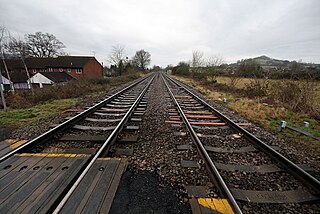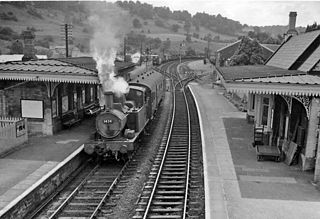
Gloucester railway station is a railway station serving the city of Gloucester in England. The station was originally built as the terminus of the Birmingham and Gloucester Railway in 1840, but the arrival of the Bristol and Gloucester Railway and Cheltenham and Great Western Union Railway in 1844, and then conversion to a through station for the South Wales Railway in 1851 resulted in a very complex layout. Subsequent closures and rationalization have left Gloucester with a station that is located off the main Bristol-Birmingham line, meaning Great Western Railway services must reverse, while CrossCountry and Transport for Wales services continue to Newport.

Stonehouse railway station is a railway station that serves the town of Stonehouse in Gloucestershire, England. The station is located on the Swindon-Gloucester "Golden Valley" line.
The Bristol and Gloucester Railway was a railway company opened in 1844 to run services between Bristol and Gloucester. It was built on the 7 ftBrunel gauge, but it was acquired in 1845 by the 4 ft 8+1⁄2 instandard gauge Midland Railway, which also acquired the Birmingham and Gloucester Railway at the same time.

Caldicot railway station is a part of the British railway system owned by Network Rail and is operated by Transport for Wales. It serves the town of Caldicot in Monmouthshire, Wales. It is located between Chepstow and the city of Newport on the Gloucester line; the line to Bristol via the Severn Tunnel runs just to the north but there are no platforms here; however, Severn Tunnel Junction station is within walking distance for those wanting to travel to Bristol.
The Cheltenham and Great Western Union Railway was a railway company intended to link Cheltenham, Gloucester and Swindon, in England. It was authorised in 1836 but it found it very hard to raise money for the construction, and it opened only a part of its line, between Swindon and Cirencester, in 1841. It sold its business to the Great Western Railway, which quickly built the line through to Gloucester in 1845 and Cheltenham in 1847; part of that route was shared with other companies.

Mangotsfield railway station was a railway station on the Midland Railway route between Bristol and Birmingham, 5.1 miles (8.2 km) north-east of Bristol Temple Meads and 82 miles (132 km) from Birmingham New Street, serving what is now the Bristol suburb of Mangotsfield. The station was opened in 1845 by the Bristol and Gloucester Railway, but had very little in the way of passenger amenities. The station was resited in 1869 to serve the new Mangotsfield and Bath Branch Line, and became an important junction station with extensive facilities and six platforms. Passenger footfall however failed to match the station's size, though at its peak eight staff were employed. The station closed in 1966 when services to Bath ended as part of the Beeching cuts, and the line through the station closed in 1969. The railway became a cycle path in the 1980s, and is a popular resting point on the route as several of the station's walls and platforms are still in situ.
The Stonehouse and Nailsworth Railway was a short railway line in the county of Gloucestershire, England. It was promoted independently to connect the industrial town of Nailsworth to the main line railway network at Stonehouse. It opened in 1867, but was immediately in financial difficulty, due largely to debenture interest payments and other financial commitments from the construction.
The Oxford, Witney and Fairford Railway was a single track railway branch line, 22 miles (35 km) long, in Oxfordshire and Gloucestershire. It was opened in succession by two companies, the first in 1861 to connect the important woollen town of Witney to the main line network, and the second in 1873 as the rump of an ambitious scheme to connect to Cheltenham, but which ran only between Witney and Fairford. The junction with the main line was at Yarnton, north of Oxford.

Downfield Crossing Halt was on what is now the Golden Valley Line between Stroud and Stonehouse.

Ebley Crossing Halt was opened on 12 October 1903 on what is now the Golden Valley Line between Stroud and Stonehouse. This line was opened in 1845 as the Cheltenham and Great Western Union Railway from Swindon to Gloucester and this was one of many small stations and halts built on this line for the local passenger service.

Bowbridge Crossing Halt was opened on 1 May 1905 on what is now the Golden Valley Line between Kemble and Stroud. This line was opened in 1845 as the Cheltenham and Great Western Union Railway from Swindon to Gloucester and this was one of many small stations and halts built on this line for the local passenger service. This halt opened with the introduction of the GWR steam railmotor services between Stonehouse and Chalford.
Ham Mill Halt was opened on 12 October 1903 on what is now the Golden Valley Line between Kemble and Stroud. This line was opened in 1845 as the Cheltenham and Great Western Union Railway from Swindon to Gloucester and this was one of many small stations and halts built on this line for the local passenger service. This halt opened with the introduction of the GWR steam railmotor services between Stonehouse and Chalford.

Brimscombe Bridge Halt was opened on 1 February 1904 on what is now the Golden Valley Line between Kemble and Stroud. This line was opened in 1845 as the Cheltenham and Great Western Union Railway from Swindon to Gloucester and this was one of many small stations and halts built on this line for the local passenger service. This halt opened following the introduction of the GWR steam railmotor services between Stonehouse and Chalford. The halt was between Brimscombe and Stroud, and featured staggered platforms either side of the overbridge for the local road "Brimscombe Hill", with the down platform on the East side and the up platform on the West. Access to the basic wooden platforms was from the overbridge. Each with GWR pagoda style shelters soon after opening and electric lighting was installed in February 1939 at an estimated cost of £90.

Brimscombe was opened on 1 June 1845 on what is now the Golden Valley Line between Kemble and Stroud in Gloucestershire. This line was opened in 1845 as the Cheltenham and Great Western Union Railway from Swindon to Gloucester, and this station opened 3 weeks after the general opening of the line, originally as "Brimscomb". The station was renamed as "Brimscomb near Chalford" in June 1865 and finally to Brimscombe on 2 August 1897.

St Mary's Crossing Halt was opened on 12 October 1903 on what is now the Golden Valley Line between Kemble and Stroud. This line was opened in 1845 as the Cheltenham and Great Western Union Railway from Swindon to Gloucester and this was one of many small stations and halts built on this line for the local passenger service. This halt opened with the introduction of the GWR steam railmotor services between Stonehouse and Chalford.
Sharpness railway station served the village of Sharpness in Gloucestershire, England.
Crank Halt was a railway station serving the village of Crank, Merseyside, England on the St Helens to Rainford Junction then Ormskirk line.

The Tetbury branch line was a 7.5-mile (12.1 km) single-track branch railway line that connected Tetbury with the main line at Kemble on the line between Swindon and Gloucester.

Chalford railway station was situated on the Great Western Railway's Golden Valley Line, between Swindon and Gloucester. It was just east of the bridge carrying Cowcombe Hill over the railway. To the east of the station site lies Chalford Viaduct, and beyond that, Sapperton Long Tunnel.

North Filton Platform was a railway station which served the northern part of Filton, Gloucestershire, England. It was on the railway line between Filton and Avonmouth, and was situated on the western side of Gloucester Road.













